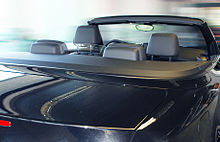Wind deflector
The term wind deflector , occasionally also called wind stop or wind protection, is understood as a partition behind the seats of an open vehicle, which deflects the vortices of air that arise behind the windshield and flows into the vehicle and keeps them away from the vehicle occupants - thus a bulkhead against the wind. The principle of a wind deflector consists of wind diversion. Wind deflectors consist of frames covered with airtight mesh, made of glass or acrylic glass.
Wind deflectors for roadsters are usually attached to the roll bars, if they are missing, attached to the vehicle with plug-in feet. The lower edge of the wind deflector sits in the body or in the interior trim or closes tightly with it.
Wind deflectors for convertibles are usually two-part and consist of the vertical wind deflector and a mesh-covered frame, a plate or a tarpaulin mounted on the lower edge. This lower part of the wind deflector prevents the downwardly deflected air vortices from flowing forward between or next to the seats. Convertible wind deflectors made of aluminum or steel frames are often foldable. They are attached to the right and left with spring rods in sockets (usually provided at the factory) in the inner lining. The lower, horizontally positioned draft-stop, frame or plate, is required to prevent the vertical draft-stop from tipping over and also serves as a cover for the rear seats. Other solutions in which the wind deflector can be placed on holders on the headrest rods or on the seat backs have a flexible tarpaulin instead of a fixed cover, which can optionally be stretched down behind the seats. The rear seats remain free.
A rear seat draft-stop consists of a mesh-covered frame or a glass or acrylic sheet and is mounted between the rear headrests. It is installed with screws, brackets or clamps on the rear shelf, on or in the interior paneling.
Rear seat wind deflectors can be sufficient for all seats, depending on the vehicle design, at city to country speed. When a spoiler is installed on the windshield frame, the airflow is diverted or increased in such a way that a rear seat wind deflector is also effective at higher speeds. There are also electrically retractable wind deflectors and rear windows that serve as wind deflectors. However, the effectiveness is limited if these panes are far back.
Wind deflectors with aluminum or steel frames are covered with fine-meshed netting. This offers a somewhat reduced view during the day, but helps against headlight glare at night. Glass and acrylic wind deflectors are frameless, almost invisible and do not restrict the view to the rear. Glass can be anti-reflective, there is no anti-reflective acrylic glass, but a changed inclination (physics: angle of incidence equals projection angle) of the wind deflector prevents glare.
Glass is (2.5 g / cm³) twice as heavy as acrylic glass (1.2 g / cm³), but it is a little more sensitive to scratches than glass. For safety reasons, glass and acrylic glass wind deflectors must be unbreakable and splinter-free. These wind deflectors are made of toughened safety glass, laminated glass (layered) or acrylic glass, for example Plexiglas GS (cast PMMA), which is approved for use in aircraft and vehicles.
Wind deflector raised in a Peugeot 307 CC






